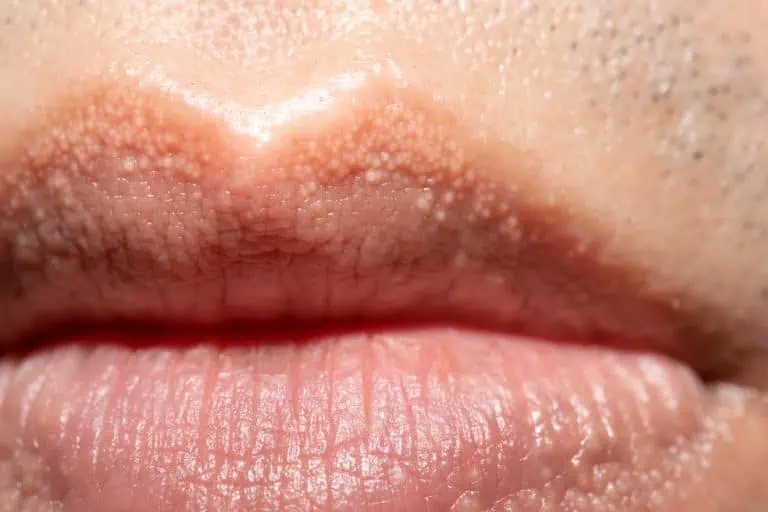Fordyce Spots: Why They Develop and How to Get Rid of Them

At some point in your life, you’ve probably had little white bumps on your face, either pus-filled whiteheads or milia (firmer bumps caused by trapped keratin). But small bumps on the border of the lips or inside the lips or cheeks may be more of a mystery. In all likelihood, these bumps are Fordyce spots. They can also appear on the genitals, causing anxiety or outright alarm.
“People often worry when they find Fordyce spots on their genitals because they think they might have a sexually transmitted infection,” said Lucy Chen, MD, a board-certified dermatologist at Riverchase Dermatology. “But unlike STIs, Fordyce spots aren’t harmful or contagious.”
In most cases, Fordyce spots treatment isn’t necessary. But because the spots can resemble STIs as well as other harmful skin conditions, such as basal cell carcinoma, it’s a good idea to have your dermatologist make a diagnosis.
“In most cases, it’s possible to distinguish Fordyce spots from other skin conditions through a visual examination,” said Dr. Chen.
What are Fordyce spots?
Fordyce spots, also called Fordyce granules or Fordyce glands, are enlarged oil glands. They got their name from the dermatologist who first described them. They are very common, especially in men and people with oily skin. The cause is unclear, but it’s thought that the spots are present at birth and become noticeable during puberty or adulthood, possibly due to increased oil production and natural changes in hormone levels.
The spots are small, ranging from 1 millimeter to 3 millimeters in diameter (between the size of a pinhead and a sesame seed), and slightly elevated. Some people have just one spot, but it’s more common to have multiple spots, which may be scattered or clustered together. They’re usually a whitish-yellow color, but spots on the genitals can be reddish. The spots are more obvious when you stretch the affected area of skin. They are not contagious.
Though Fordyce spots are usually just a cosmetic issue, there are exceptions. “They can sometimes itch, which may be embarrassing if the spots are located on the genitals,” said Dr. Chen.
Fordyce spots on the lips
Fordyce spots on the lips typically occur on the edges of the lips, where the lip meets the surrounding skin, an area known as the vermillion border. They’re distributed symmetrically, cropping up on both sides of the lips. They can also appear on the inside of the lips.
Fordyce spots on the genitals
Fordyce spots can occur on the genitals in men and women. Because they can resemble herpes sores or early-stage genital warts, see a doctor to get an accurate diagnosis if you discover spots or bumps on your genitals.
Certain clues can distinguish these spots from sexually transmitted infections. For instance, herpes causes painful blisters, and Fordyce spots don’t blister. As for genital warts, they can appear in places Fordyce spots don’t, such as inside or around the anus, inside the vagina, and in men, on the groin and thighs. Anogenital warts (warts on the anus or genitals) are caused by human papilloma virus (HPV).
Fordyce spots on the penis
Fordyce spots on the penis are common. They can appear on the shaft of the penis, the head of the penis or the scrotum. Because they are more prominent when the skin is stretched, you might notice them most when you have an erection. The spots may feel uncomfortable during sex or start bleeding, but normally they don’t cause a problem.
Fordyce spots on the labia
In women, Fordyce spots can appear on the labia, the folds of skin around the vaginal opening. They are more common on the inner labia, the folds closest to the opening. Less commonly, they occur on the outer labia or the clitoris. Like Fordyce spots elsewhere, they appear in a symmetrical pattern (the same on both sides).
Fordyce spots on the labia can sometimes resemble milia, genital warts or molluscum contagiosum, a viral outbreak that causes small, pink or flesh-colored bumps. Molluscum contagiosum is contagious, as its name implies.
Fordyce spots treatment
If the spots itch or make sex uncomfortable, or you simply don’t like how they look, there are several treatments your dermatologist can use to remove them or make them less noticeable. He or she may recommend combining topical or oral treatments with laser treatments for the best outcome.
- Topical tretinoin (Retin-A). This cream, also used to treat acne, can reduce Fordyce spots or make them disappear through the process of exfoliation
- Oral isotretinoin. A brief course of this vitamin A derivative is sometimes effective in erasing Fordyce spots. The drug works best when combined with laser treatment.
- Laser treatment. Fordyce spots can be eliminated with CO2 lasers or pulsed-dye lasers. Pulsed-dye laser treatments may be preferred because the risk of scarring is lower
- Cryotherapy. Freezing the spots with a very cold substance such as liquid nitrogen or argon gas can destroy them.
- Topical trichloracetic acid (TCA). This acid shrinks or removes Fordyce spots by cauterizing (burning) them. It works best when used in conjunction with laser treatment.
- Electrohyfrecation. The doctor uses a small, handheld device to deliver a low-level electric current to the spot, which burns it away.
- Micro-punch surgery. After applying a local anesthetic, the doctor uses a small, pen-like device to remove the spots.
If you don’t feel the need to treat your Fordyce spots — they are perfectly natural, after all — you can help prevent them from getting larger by skipping the use of oily lotions, creams and other heavy skin care products. If you’re tempted to pop the spots, don’t. You may get a cheesy or watery liquid out of them, but they won’t go away, and you may end up with an infection. Scraping them off doesn’t work, either.
Medically reviewed by Lucy Chen, MD
Written by Jessica Brown, a health and science writer/editor based in Nanuet, New York. She has written for Water’s Edge Dermatology, Prevention magazine, jnj.com, BCRF.org, and many other outlets.


